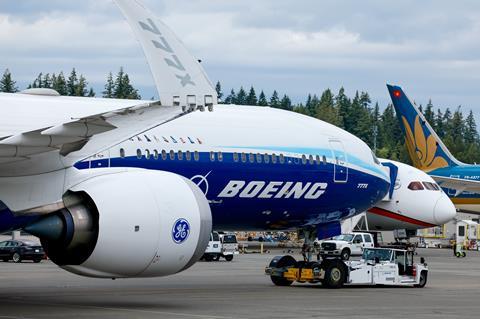Boeing completed its first certification test flight of the 777-9 on 12 July after receiving the long-delayed jet’s type inspection authorization (TIA) from the Federal Aviation Administration (FAA).
That document is a green light from the regulator, certifying that the 777-9 will likely meet certification requirements and approving the start of flight testing for certification credits.
Boeing disclosed having received the TIA on 13 July. Its current expectation is that the 777-9 will enter service next year.

“With type inspection authorization for the 777-9, we began certification flight testing with US Federal Aviation Administration personnel on board the aircraft” on the evening of 12 July, Boeing says. “The certification flight testing will continue validating the airplane’s safety, reliability and performance.”
Receiving the TIA marks a significant milestone for the 777-9 programme and brings much-needed bright news for Boeing, which in recent months has been hammered by negative press, much of it involving questions about the safety of its production system.
“We appreciate our regulator’s rigorous oversight and are grateful to our customers who have chosen the 777-9 for its efficiency, environmental performance and passenger comfort,” Boeing says.
The start of certification testing also comes as welcome news to 777-9 customers, including Lufthansa and Emirates Airline, which are expected to be the first two carriers to receive the type.
Though Boeing has stuck to its 2025 certification timeline, Emirates president Tim Clark speculated several months ago that his airline may not receive its first 777-9 until 2026. Neither Emirates nor Lufthansa immediately responded to requests for comment about the start of the certification flying.
Boeing launched the twin GE Aerospace GE9X-powered 777-9 and the broader the 777X programme in November 2013 at the Dubai air show, at the time saying the jet would make first flight in 2019 and be certificated soon after.
It has delayed the programme numerous times, including due to increased scrutiny by the FAA in response to failures made during the 737 Max’s certification. Boeing completed the 777-9’s first flight in January 2020.
In January 2021, the company pushed the 777-9’s expected certification date to 2023, citing design changes, including to actuator controls. Later that year Boeing said it needed to provide the FAA with more information about the jet’s major software architecture. In 2022, Boeing delayed first delivery until 2025.

While the company has just started fight testing for certification credit, its 777-9 test fleet has accumulated around 3,500h across more than 1,200 flights as part of Boeing’s own flight-test regime, it says.
“The 777-9 flight-test fleet will undergo the most thorough commercial flight-test effort Boeing has ever undertaken. We have also spent significant time working through the required certification deliverables in preparation for TIA,” Boeing adds.
The 777-9 will have 7,285nm (13,500km) of range and be capable of carrying 426 passengers in a typical two-class layout. At 76.7m (252ft) long, it is about 3m longer than its predecessor, the 777-300ER.
Boeing initially intended to follow the 777-9 with the smaller, longer-range 777-8 with capacity for 395 passengers.
But it paused that effort in 2019, and in 2022 changed course, saying the next 777X will be the 777-8 Freighter, a 4,410nm-range, 112t-payload jet. Boeing still eventually intends to bring the all-passenger 777-8 to market.
The company holds orders for 481 of the new widebody jets.
Boeing’s 777-9 flight-test fleet includes four aircraft. Test jet “WH001” has been assigned avionics, brakes, flutter, icing, stability and low-speed aerodynamics testing, and “WH002” is handling ground-effect aerodynamics, auto-land, and stability and control tests.
Boeing is using test aircraft “WH003” to validate handling, avionics, propulsion and the auxiliary power unit, while “WH004” has been assigned extended-operations, environmental-control system, reliability and noise evaluations.


























